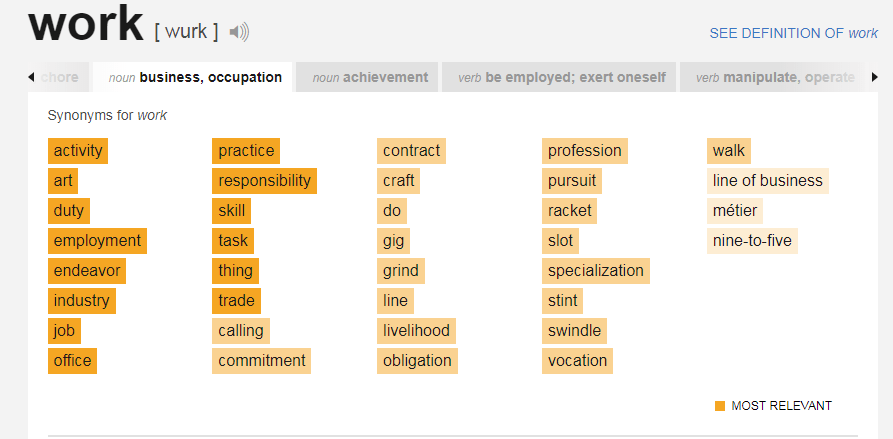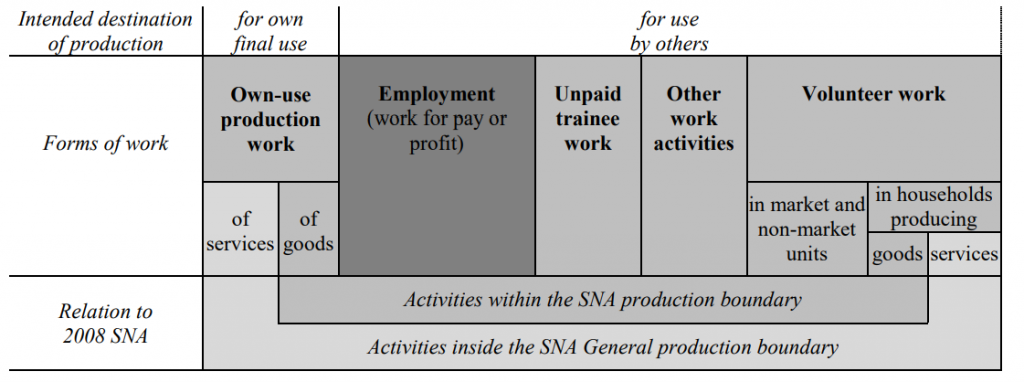In everyday language, work and employment are synonyms. We use them interchangeably to refer to how we make a living.
In everyday language, we can afford to be vague or use approximate words. We are simply trying to make ourselves understood. So, we are not forced to look for the most precise word at every turn.

However, things are very different in the world of statistics. We produce statistics to have an accurate picture of the state of the world. Statistics help make the invisible visible. They bring issues to light and force us to face facts. But for all that, we must be precise in how we define each term used in statistical collection. We must be precise in what we include under each label.
Work and employment
Until recently, labour statistics focused only on one specific type of work: work done for pay or profit. This type of work is what in labour statistics jargon we call employment.
Employment = any activity to produce goods or provide services for pay or profit.
After a long history of overlooking all types of work that were not employment (thus also overlooking their impact on production, the economy and societies), the international community finally recognized the need to measure all forms of work at the 19th International Conference of Labour Statisticians in 2013. Realizing that employment represented only a small portion of all work done by people around the world, we decided to come up with a precise statistical definition of work, encompassing all forms of work.
Work = any activity performed by persons of any sex and age to produce goods or to provide services for use by others or for own use.
Forms of work framework
It was also necessary to clearly identify and define each possible form of work. For this, we followed two main criteria: the intended destination of the production (for own final use or for use by others) and the nature of the transaction (i.e. monetary or non-monetary transactions, and transfers). This lead us to define the following forms of work:
– own-use production work: production of goods and services for own final use;
– employment work: work performed for others in exchange for pay or profit;
– unpaid trainee work: work performed for others without pay to acquire workplace experience or skills;
– volunteer work: non-compulsory work performed for others without pay; and
– other work activities.

It is possible (and even common) to be involved in more than one form of work at once. For instance, employed people may volunteer or grow their own vegetables. Unpaid interns may have a job on the side to support themselves. Volunteers may be making their own clothing or building their own furniture or doing an unpaid internship, and so on.
Forms of work and labour force status
Employment is not only a form of work, it is also a labour force status. People’s labour force status refers to their participation in the labour force. That is, whether or not they make up the supply of labour available in the economy for producing goods or services in exchange for remuneration.
Labour force = current supply of labour for the production of goods and services in exchange for pay or profit.
For people who are not in employment, their labour force status depends on whether or not they are looking for a job and whether or not they are available for one. Those who are not employed but are seeking and available for employment are considered unemployed, and the rest are outside the labour force.
Unemployment = people of working age not in employment, looking for employment and available for employment.
The unemployed and people outside the labour force are by definition not in employment. Nonetheless, they may be actively participating in other forms of work, contributing to the economy and the community. For example, retired people, homemakers and students (usually outside the labour force) may be doing volunteer or own-use production work. Similarly, someone in unemployment may volunteer or do an unpaid internship while looking for a job.
For more information on the forms of work framework, please see the resolution adopted by the 19th International Conference of Labour Statisticians.
Author
-
Rosina Gammarano
Rosina is a Senior Labour Statistician in the Statistical Standards and Methods Unit of the ILO Department of Statistics. Passionate about addressing inequality and gender issues and using data to cast light on decent work deficits, she is a recurrent author of the ILOSTAT Blog and the Spotlight on Work Statistics. She has previous experience in the Data Production and Analysis Unit of the ILO Department of Statistics and the UN Resident Coordinator’s team in Mexico.
View all posts
